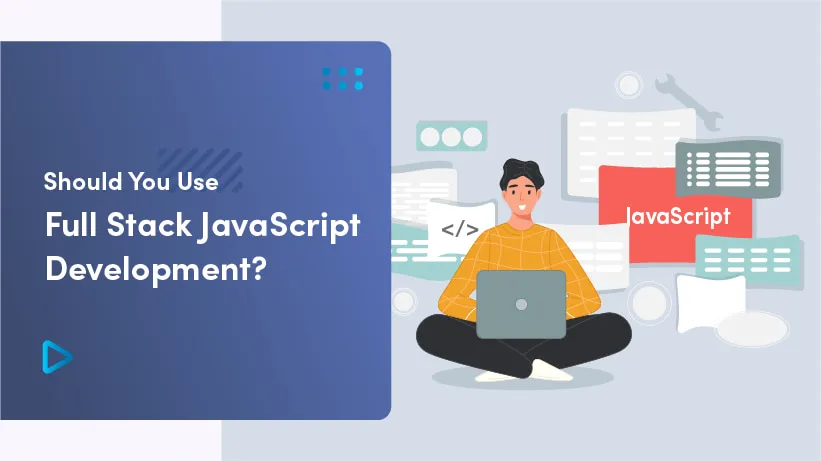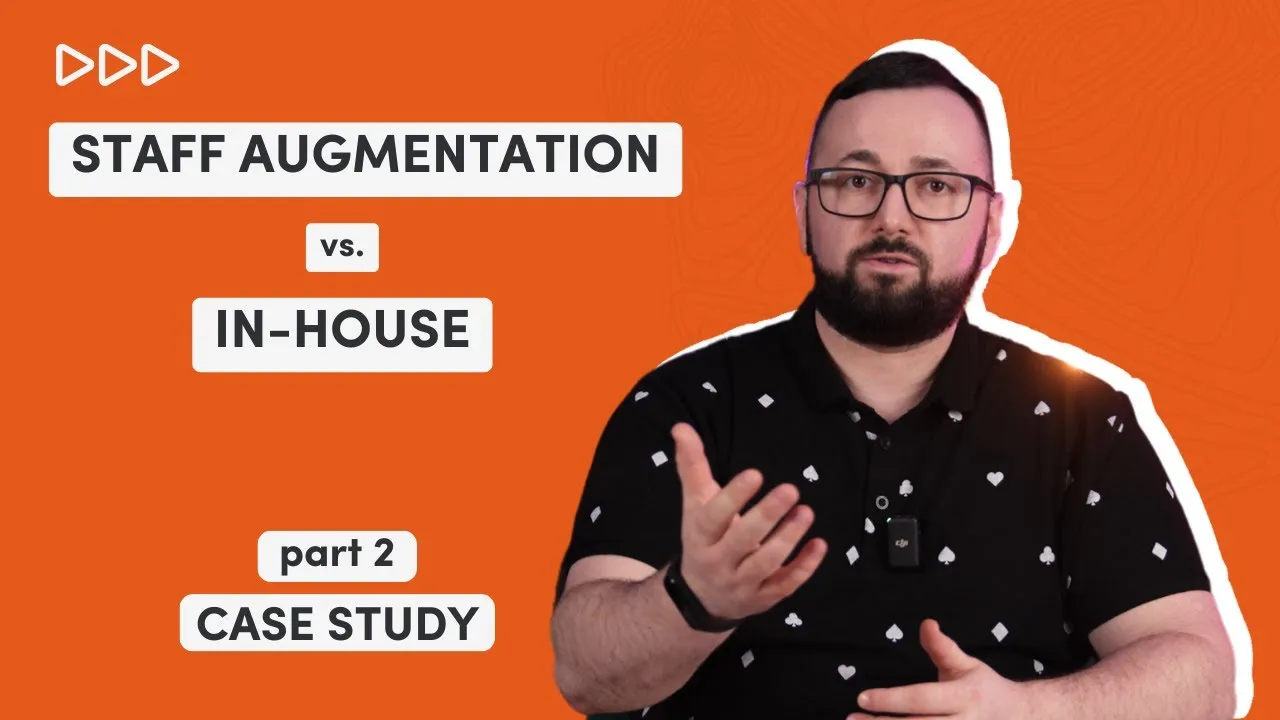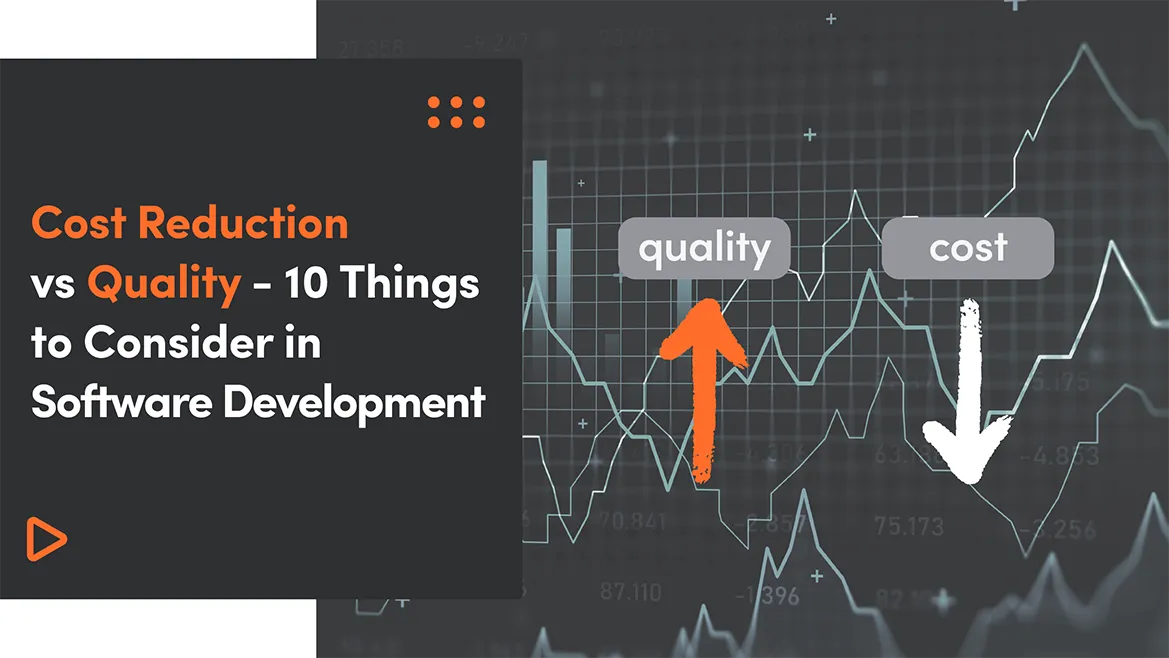Technology aims to bring simplicity and feasibility among the processes, such as JavaScript becoming a widely used programming language because it is simple and provides the ability to develop a whole software solution using only one technology.
Initially used in front-end engineering, JavaScript can now be integrated into the server side, which has increased its popularity even more. Full Stack development allows web or mobile apps to be created from start to end, encompassing both the project's front-end and back-end with a single technological stack.
Since now JavaScript can be used in both the front-end and the back-end, would you consider using it for an entire business project? Would you hire a Full Stack JavaScript developer to work on your web project? Is it a good idea to use Full Stack JavaScript Development? Let’s find out!
Why Full Stack JavaScript is the Talk of the Town?
Since web server technologies have evolved dramatically: we've seen a slew of new languages and technologies emerge, including PHP, ASP, JSP,.NET, Ruby, and Python, to mention a few. Developers realized that employing two separate languages for client and server-side made things more complicated. And, that is why Full Stack is the priority choice for many development companies worldwide.
What is Front-end Development?
The part of web development that focuses on users' views on their end is known as front-end development. It entails converting back-end developers' code into a graphical interface and ensuring that data is displayed in an easy-to-read and comprehend style.
Everything you see on Google Apps, Canva, Facebook, and other online services results from the collaboration between back-end and front-end engineers.
What is back-end development?
Back-end development languages handle web applications' 'behind-the-scenes' functionality. It's the code that links the web to a database, keeps track of user connections, and runs the web application. To deliver the final result to the end-user, back-end development works in collaboration with front-end development.

Let’s get started with a detailed introduction of Full Stack JavaScript.
An Introduction To Full Stack JavaScript - Definition
The concept behind "Full Stack JavaScript" is that all software in a web application should be written entirely in JavaScript, both client and server-side.
Client Software (Front-End)
- HTML
- CSS
- Bootstrap
- W3.CSS
- JavaScript
- ES5
- HTML DOM
- JSON
- XML
- jQuery
- Angular
- React
- Nextjs
- Gatsby
- Backbone.js
- Ember.js
- Redux
- Storybook
- GraphQL
- Meteor.js
- Grunt
- Gulp
- Sass
- Less
Server Software (Back-End)
- Node.js
- Express.js
- Koa.js
- Sails
- Fastify
- NestJS
- Deno
- REST
- SQL
- MongoDB
- AWS
- Heroku
- Google Cloud Platform
- Firebase.com
- Parse
- PaaS - Azure and Heroku
Full Stack Developer Role and Skills
A Full Stack Developer is a software professional who can work on both the front-end (client-side) and the back-end (server-side). Full Stack Developers understand each layer of the technology stack that goes into creating a software product. They know the operations of each layer and, more significantly, can modify all back-end components.
In addition to mastering HTML and CSS, he/she also knows how to:
- Program a browser (like using JavaScript, jQuery, Angular, or Vue)
- Program a server (like using Node.js)
- Program a database (like using MongoDB)
What are the Crucial Full Stack Developer Skills?

A Full Stack developer must have the following skills.
HTML/CSS
Full Stack Developers must work with HTML to use markup to determine the structure of web pages. For efficient display of HTML components, they must also be CSS experts. For designing an interactive, intuitive, and engaging front-end for apps. Full Stack Developers must have strong experience in both of these programming languages.
JavaScript
Full Stack Developers must be well-versed in JavaScript and related ideas and functionalities such as React and Angular. One of the greatest things about JavaScript is that it comes with a slew of useful features like functions, prototypes, higher-order event delegation, and closure, all of which aid in developing flexible web pages.
Git and GitHub
They must be familiar with all of the fundamental Git commands and examples. Full Stack Developers familiar with Git can better interact and communicate with their fellow developers/programmers on the same project.
Node.js
Full Stack Developers must understand the intricacies of web architecture. They must know how to organize code, organize files, arrange data in databases, and execute the necessary computational activities because their major role is to develop complex software applications from scratch.
HTTP and REST
Since HTTP and REST are necessary for Full Stack development, he/she must master both.
Basic Design Skills
Thus, Full Stack Developers must know the basic design principles, including UI & UX design, prototypes, scalability, etc.
Soft Skills
Every Full Stack Developer must have the following soft skills:
- An analytical bent of mind
- Good time management skills
- Curiosity for learning
- Attention to detail
- Creative vision
- Patience
Advantages & Disadvantages of Full Stack JavaScript
Like every other technology, Full Stack JavaScript offers both advantages and disadvantages. Let’s see if the proportion of the benefits is higher than the drawbacks of using the technology.
Advantages

Here’re the advantages of using Full Stack JavaScript.
More Efficiency, More Productivity
Full Stack JavaScript Developers may work on a web project solely in that programming language, making it easy for everyone in the team to follow along. In other words, because the front-end and back-end developers all use the same language, they are constantly up to date on the project's status.
Higher Performance
Full Stack JavaScript developers can use Node.js to build completely asynchronous apps and take advantage of non-blocking programming. As a result, the programs can execute numerous processes independently at the same time. As a result, web apps created purely in JavaScript run better, giving users a better experience and higher-quality products.
More Code Reuse
You can reuse parts of code that follow similar logic and implementation since both the back-end and front-end utilize JavaScript. This can cut down on the amount of code Full Stack JavaScript developers have to write and the total number of lines of code for the project.
Access To Open Source Tools
Virtually the whole MEAN stack is open source, which means you'll receive free access to well-tested tools. Because they are open source, they are updated regularly by their respective communities, which provides a lot of value to their users.
More Talent Available
There are many individuals (experienced developers) out there that know and use this programming language regularly, providing you with a large pool from which to recruit new talent for your Full Stack projects.
Improved Teamwork
Any industry benefits from collaborative efforts. This is especially true in the case of software development. The likelihood of misunderstandings between coworkers is lowered when developers are proficient in both back-end and front-end development.
Time and Money Saving
All of the benefits listed above are related to saving time and money. It is widely assumed that a high-quality product cannot be economical. You don't have to worry about hiring a front-end specialist and a back-end specialist separately when working with Full Stack programmers. All of these concerns may be addressed by a single Full Stack JavaScript developer.
Choice of the Giant Corporations
Google, Facebook, and Netflix are among the companies that use JavaScript programming. Isn't it implausible that they'd instead employ inferior technology in their projects?
Disadvantages

The list of advantages is lengthier than that of the disadvantages, but let’s look at all the disadvantages of using Full Stack JavaScript.
Not Suitable for Heavy Computing
At the same time, this is not the technology to use for high-performance computing. Due to the computational process, incoming requests may be stopped, making it difficult for the program to execute properly. If you are not planning to design such solutions, though, you can safely overlook this flaw.
All-in-One Drawbacks
Full Stack JavaScript development brings together many technologies at once, along with all of its drawbacks. Of course, as technology advances, all of these difficulties will be remedied.
Small-Sized Database
So far, Full Stack development, like its database, has been a relatively new technology. The situation is changing as a result of its adoption by major corporations.
Limited Capabilities on Server-Side
After focusing solely on the front-end, JavaScript offered server-side features, as indicated in the introduction. Any experienced back-end engineer can see the constraints that this lack of maturity brings to the task, especially when compared to more established options like PHP or Java.
"True" Full Stack Developers Scarcity
It isn't easy to find engineers capable of delivering on both ends, which is why some people compare full-stack JavaScript developers to unicorns.
What is Full Stack JavaScript Development Suitable for?
As a rule of thumb, Full Stack JavaScript development is suited for projects like:
- P2P apps and services
- IoT products
- eCommerce platforms
- Fintech applications
- Web-based enterprise applications
What Is A Stack?
A "Stack" is a set of programming languages, technologies, or software products. The technology stack and the application stack are the two types of development stacks.
- MERN/PERN
- MEAN Stack
What is the MERN Stack?

A stack is the set of technologies that go into making a web application. Any web application will be built with various technologies (frameworks, libraries, databases, etc.).
The MERN stack is a JavaScript stack created to make the development process go more smoothly. MongoDB, Express, React, and Node.js are the four open-source components that make up MERN. These components give developers an end-to-end framework with which to operate.
The Benefits of the MERN Stack
- both front-end and back-end written in JavaScript
- supports MVC architecture for a smooth development
- developers can use the MERN stack to create very efficient web apps.

Disadvantages of Mern Stack
- React is heavily reliant on third-party modules such as Redux, Babel, and others. As a result, it may be both advantageous and disadvantageous.
- On the one hand, it may be developed by various developers; nevertheless, if these modules are not properly maintained, they may cause problems in the future. On the other hand, the community is actively involved in adding to, maintaining, and upgrading these modules.
What is MEAN Stack?

The MEAN stack is a JavaScript-based software stack (i.e., a collection of technological layers that make up a contemporary application). MEAN heralds the advent of JavaScript as a "full-stack development" language capable of handling everything from the front-end to the back-end of an application.
Advantages of MEAN
These four elements functioning together aren't the answer to every problem, but they've indeed found a place in modern development. IBM explores the areas where the MEAN stack is appropriate. The MEAN stack is an excellent solution for cloud-native apps since it is scalable and can manage many users at once. Single-page applications benefit significantly from the Angular front-end. Here are several examples:
- Expense-tracking apps
- News aggregation sites
- Mapping and location apps
MEAN also provides benefits like:
- resists redundant grunt work to keep development organized
- has a built-in extensive tool testing suite
- an open-source framework with an excellent community support
Angular vs. React – Which one is Best?
AngularJS is a framework for building dynamic online projects, whereas React is a javascript library for creating user interface components. MVC (Model View Controller) is the foundation of AngularJS, whereas Virtual DOM is the foundation of React. React is based on Javascript, while Angular is based on Typescript.

Disadvantages of Mean Stack
- Not recommended for large-scale applications.
- No specific general JS coding guidelines.
- Once you have developed the first site using Mean stack technology, it's tough to go back to the old approach.
- It offers poor isolation of the server from business logic.
- You could lose records gradually.
Implementing Full Stack Development - What to Consider
Application-level and middleware programming: Integrating all needed pieces, such as the cloud, the gateway, and all distributed aspects, is necessary. This will aid in the standardization and facilitation of data and information sharing across various devices.
Cloud Development and Operations
IoT applications often require cloud infrastructures such as Amazon AWS, Microsoft Azure, and others for development and operations. To make applications more resilient in the face of outages, an understanding of cloud development and application is essential.
Integration with other Systems
To benefit from the contextual value supplied by the IoT system, OT systems must connect and interact with business applications. To improve the entire digital experience, IoT applications may need to interface with other devices or services.
Relational and Non-Relational Databases
Several linked devices in an IoT system communicate data with one another. To do data visualization and analysis, all of this information must be acquired. Knowledge of several database types aids in the ingestion and analysis of device data.
Security
To avoid any harm, security awareness is necessary, as each layer has its own set of vulnerabilities. Device authentication and authorization are also critical for IT system security.

User Interface and User Experience
Understanding what the consumer will see and feel through your application or website requires both UI and UX knowledge. Implementing a web portal for remote monitoring of millions of devices from a single console, for example, is beneficial to the team that monitors and oversees the operation of such devices in any home automation system.
Business and Customer Requirements
Having a rudimentary concept of what consumers expect from a product will guarantee that the project does not become derailed due to a lack of requirements understanding. This expertise may assist produce a viable and successful product or system at each stage of the delivery process - scoping, designing, constructing, and testing.
Conclusion
Is JavaScript Full Stack the right technology for you? Is it what you need to boost your revenue, meet your user requirements and make your business process flow smoothly? The answer to all these questions lies among the experts.
If you are one with ideas to shift your business on JavaScript Full Stack or want to develop a new web or app using the same technology then talk to us. We have a team of highly professional-experienced Full Stack developers who can help in faster time-to-market, reduction in startup cost, easy scalability and flexibility with solutions that will speak of their own success. So, don’t wait, contact us now!




